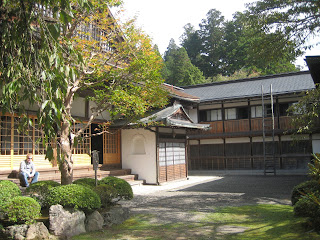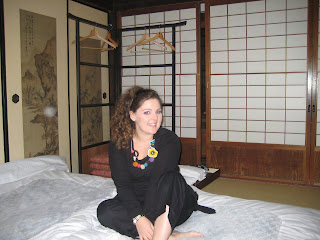













 Actually, I was a little uneasy about heading to Koyasan. It's kind of an extension of what I like to call my 'Harry Potter complex'. It spreads to all areas of my life including the Star Wars hexology (what does a set of 6 films get called), 'The Hills' and 'Gossip Girl' viewing, a trip to Torquay and Tim Tam slams. Where am I going with this? Well folks, I'm not one for bandwagons. I don't like jumping onto something that others swear is 'the best' or 'the most amazing' or 'the most incredible' or whatever other extreme statement they may use to describe one experience or another. I like to discover things by myself and I guess I just don't always take someone's word for it when they say something is awesome. The couple of times I've followed other's advice recently has led me to two of the worst meals I've had in Japan, so I feel confident in my ignorant snobbery. Anyway, so we decided to jump on the Koyasan bandwagon when a long weekend loomed ahead of us back in early October and one too many people had recommended the Shokubo experience as one not to be missed. Shokubo is temple lodging and is particularly famous in the mountainous area of Wakayama, near Osaka, on Mount Koya, or Koyasan. Koyasan is famous for its long history of Spiritual importance for Buddhists. Here's some wiki action:
Actually, I was a little uneasy about heading to Koyasan. It's kind of an extension of what I like to call my 'Harry Potter complex'. It spreads to all areas of my life including the Star Wars hexology (what does a set of 6 films get called), 'The Hills' and 'Gossip Girl' viewing, a trip to Torquay and Tim Tam slams. Where am I going with this? Well folks, I'm not one for bandwagons. I don't like jumping onto something that others swear is 'the best' or 'the most amazing' or 'the most incredible' or whatever other extreme statement they may use to describe one experience or another. I like to discover things by myself and I guess I just don't always take someone's word for it when they say something is awesome. The couple of times I've followed other's advice recently has led me to two of the worst meals I've had in Japan, so I feel confident in my ignorant snobbery. Anyway, so we decided to jump on the Koyasan bandwagon when a long weekend loomed ahead of us back in early October and one too many people had recommended the Shokubo experience as one not to be missed. Shokubo is temple lodging and is particularly famous in the mountainous area of Wakayama, near Osaka, on Mount Koya, or Koyasan. Koyasan is famous for its long history of Spiritual importance for Buddhists. Here's some wiki action: Mount Kōya (高野山 Kōya-san) is a mountain in Wakayama prefecture to the south of Osaka. First settled in 819 by the monk Kūkai, Mt. Koya is primarily known as the headquarters of the Shingon sect of Japanese Buddhism. Located in an 800 m high valley amid the eight peaks of the mountain, the original monastery has grown into the town of Koya, featuring a university dedicated to religious studies and 120 temples, many of which offer lodging to pilgrims. The mountain is home to the following famous sites:
- Okunoin (奥の院), the mausoleum of Kūkai, surrounded by an immense graveyard (the largest in Japan)
- Konpon Daitō (根本大塔), a pagoda that according to Shingon doctrine represents the central point of a mandala covering not only Mt. Koya but all of Japan
- Kongōbu-ji (金剛峰寺), the headquarters of the Shingon sect
In 2004, UNESCO designated Mt. Koya, along with two other locations on the Kii Peninsula, as World Heritage Sites.
So, Mount Koya is exceptional. Our experience there, staying for one night and two days in an actual Buddhist temple (with real live monks!!!) has been an unparallelled experience for us in Japan. I think Ross probably got sick of my oohing and aahing and attempting to explain my Koyasan amazement, but I'm gonna give it one more go, for you guys tuning in at home! Koyasan has something like 200 temples nestled in the mountain setting, but of these 200, 50 open themselves up to Shkubo temple lodging. Staying in a temple overnight means eating traditional Buddhist fare (no meat, plenty of strange looking things but very special and really delicious) and attending morning services (sitting in the temple, listening to the monks chanting, pins and needles from sitting still for an hour, the whole deal.) This experience in itself was one we were really looking forward to, but arriving to find that our surprisingly luxurious room overlooked a gorgeous little Japanese garden and we really were staying in a temple (with real live monks!!!) was quite a profound experience. Add to this sightseeing at night and during the day in an ancient graveyard covered in moss and built in the forest from old, worn stones and we really had an experience that I have since expressed (to poor Ross repeatedly and to anyone else who'll listen) as being one that i really had no point of reference or comparison for. It was just so unique and so special. We travelled by train to Koyasan, actually two trains (one where we initially left our luggage then raced to grab it as it prepared to leave) and then finished the trip there with a ride in an amazing cable car up the side of the mountain then a local bus. It always amazes me in Japan the distance that public transport spans and the standard of service wherever you go. We were two of about five people on the train heading to Koyasan that Sunday and where in Australia it would have definitely been by car or take the one per day Vline, we traveled on trains that would continue going back and forth throughout the day and night. I have since queried this with many students who tell me that the public transport system in Japan, though fantastic for us consumers is actually steeped in debt. Basically from running too many trains with not enough people riding them. Oh well. Sometimes reality's just a bit depressing, hey? :) Anyway, so we rode to Koyasan for most of our trip with another couple sitting opposite us. It was awkward because the couple were about our age, looked Aussie, eventually spoke to each other; confirming they were Australian and yet we rode for so far with them without speaking that it got to a point where neither couple could say anything because we hadn't made the effort earlier. Awkward. Then we got off the bus at the wrong stop and had to walk the last 500 metres or so to our temple...only to find that they had not made an error in bus stop disembarkation and were in fact staying in the same temple as us. Axkward. Then Ross chatted to them and all was fine and the awkwardness was forgotten. A lovely couple, hailing from Geelong and Colac - small world, hey?! They were really sweet and we ran into them often...in fact we ate next to them in a private two couple room for all our meals, ran into them while walking at night, then ran into them as we bathed naked in the communal Japanese style baths. Lucky Ross sorted that earlier awkwardness out...
We spent our time in the temple feeling cold and playing with the Kotatsu in our room (a table with a kind of blanket over it and a heating element under it, really popular in Japanese homes as a method of keeping warm in Winter), drinking cups of tea, pretending to be ninjas and Buddhist priests and anything else 'traditional' that came to mind (oh yeah, tourists for the weekend) and exploring the temple grounds. It was amazing accommodation. We took a night walk in the apparently haunted Okunoin (the forest cemetery), then walked through it again the next day, took photos with the first red maple leaves and ate amazing noodles and curry at the station. One thing I hope I will never forget (but that living here I definitely take for granted) is the amazing food that is readily available fresh and cheap and delicious everywhere here; even at the station! You never have to worry about going hungry or having to settle for crappy sandwiches or snacks from a pie warmer...although right now as I sit in 4 degree cold in my apartment writing this; I really could go a four and twenty.....
Ours was just a short trip to Koyasan, but well worth it and one of the best experiences for us thus far, so whilst I'm not eating my wors just yet on the recommendations from others...I do thank everyone for insisting we 'do Koyasan'.


No comments:
Post a Comment